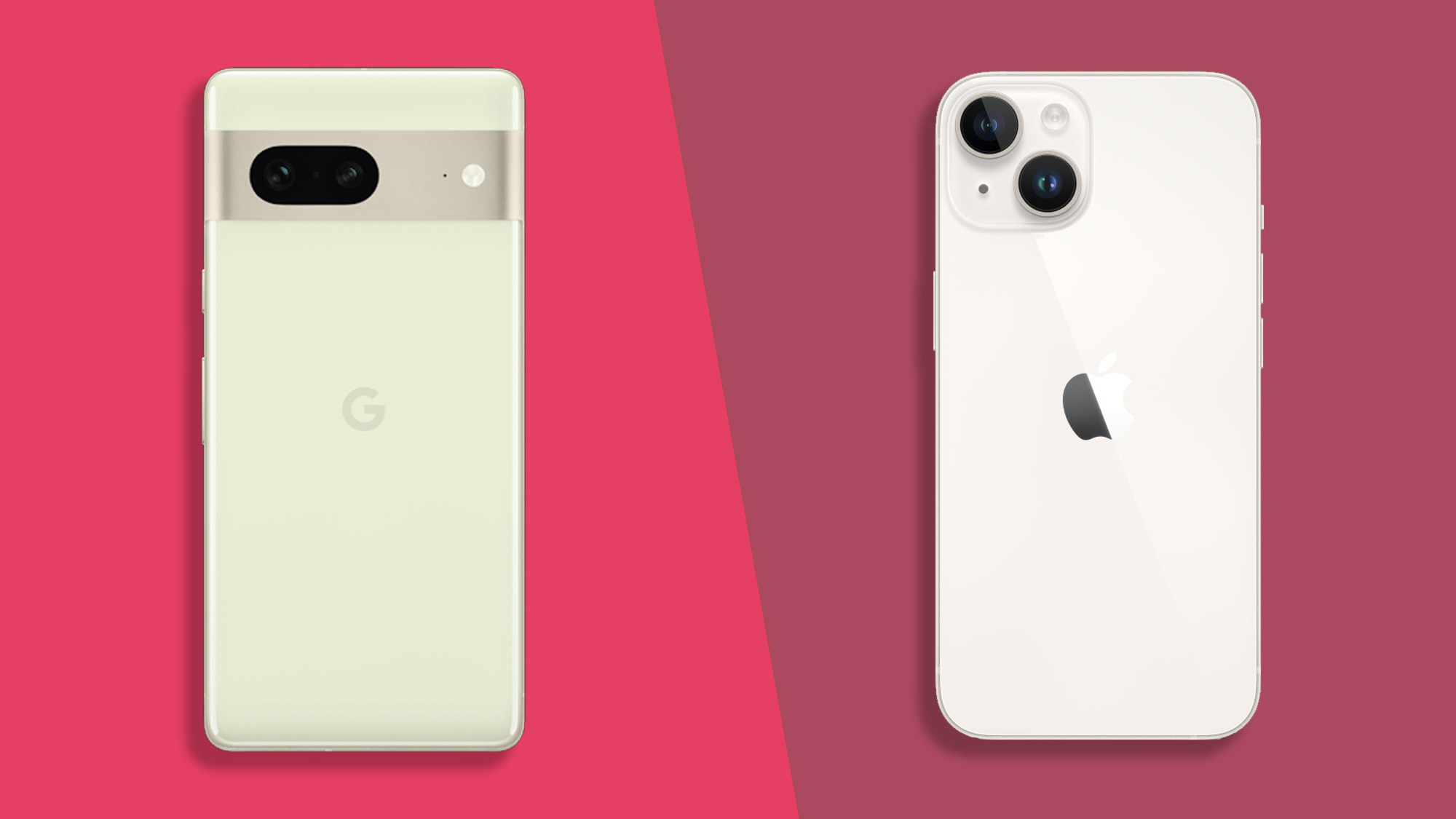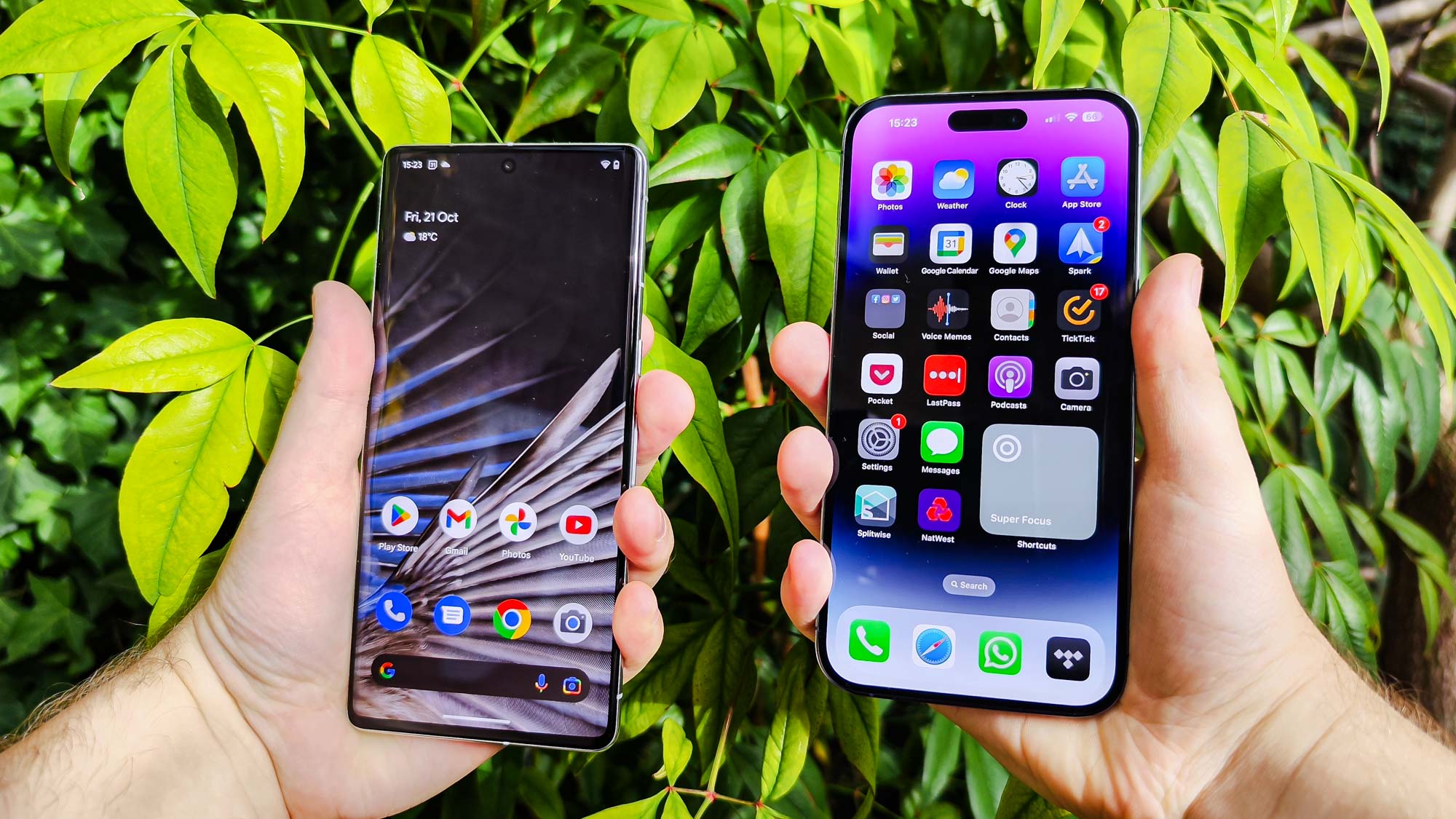Finn ut hvilken telefon som er best mellom Google Pixel 7 og iPhone 14. Vi sammenligner forskjellige funksjoner og vurderer dem opp mot hverandre. Bestem deg for hvilken smarttelefon som passer best for deg. Les mer på GadgetsLand.
Innholdsfortegnelse
Specs
Smartphone users are spoilt for choice when it comes to excellent devices this year. No sooner had Apple announced the iPhone 14 in September than Google followed it with the Pixel 7, which, much like its iOS rival, takes the features that had made its predecessors such popular devices and adds a few extra for good measure. On top of the superb camera and long battery life of previous generations, it throws in compatibility with the newly revealed Pixel Watch while it also offers an attractively redesigned rear camera module.
The question is, how does it compare to the iPhone 14? We answer this question by looking at the different features of each and weighing them up against each other. That way, you should be able to decide which smartphone is for you.

Design, display, and durability
While neither phone goes for reinvention, the Pixel 7 does at least try something noticeably different with its design. Whereas the Pixel 6 featured a horizontal camera visor made of glass, the seventh generation goes with aluminum this time around. This means it ditches the black, darkened appearance of the Pixel 6 and features something arguably a little sharper and more striking. On top of this, the Pixel 7 also ditches the two-toned coloring of the Pixel 6’s rear, instead going for a single shade over its entire surface, which you can have in either Obsidian (basically black), Snow, or Lemongrass (light green).
The iPhone 14, however, changes nothing from the iPhone 13. To be fair, the latter was hardly an ugly duckling, yet the lack of adventurousness on the part of Apple arguably marks down the iOS device a little.
Moving on to displays, the Pixel 7 sports a 6.3-inch AMOLED panel, which is capable of supporting a nice 90Hz refresh rate. It also packs 2400 x 1080 pixels, making for 416 pixels per inch (ppi). As for the iPhone, its 6.1-inch Super Retina OLED screen bests the Pixel in terms of its resolution at 2532 x 1170 pixels (i.e., 460 ppi). Unfortunately, it has a refresh rate of only 60Hz, something that deprives it of the kind of smoothness and fluidity (in scrolling and animations) enjoyed by Google’s device.
As such, the Pixel wins this round by a narrow — but not insignificant — margin. Both phones carry an IP68 rating, so neither has the edge in terms of durability.

Performance, battery life, and charging
The Pixel 7 runs on Google’s very own Tensor G2 chip, which is the successor to last year’s version. It’s built using Intro
This has opened a position for direct competitors like Google's Pixel 7, which features just as few improvements as the iPhone 14. Google has sort of soft-rebooted the Pixel lineup after the somewhat disappointing Pixel 5 midranger, and the Pixel 7 is definitely a step in the right direction as well. Let's see how it compares to the iPhone 14.
Se også
Design and Display Quality
There aren't major changes in the iPhone 14's general design language, but the Pixel 7 sports an intriguing update to its rear camera strip that makes it stand out in comparison with both its predecessor, and the iPhone 14.
The Pixel 7 carries the same flat display at the front with the matte camera strip getting one less camera than the Pixel 7 Pro, but they are now fitted in a pill-shaped form for a classier, more eye-pleasing look. The Pixel 7 is larger and heavier than the iPhone, as it has a bigger display, and brings with it a boxier look and feel in the hand.
Google uses a single color for the glass back and a polished metal frame in a complimentary color for the camera bar. These are little elements, but it appears that Google has gotten them right, since the latest Pixels indeed look extremely nice.
When it comes to the display, the iPhone 14 retains the 6.1-inch OLED display that was used on the iPhone 13 and iPhone 12, and didn't score a high refresh rate display (this one only graces the iPhone 14 Pro and iPhone 14 Pro Max).
The Pixel 7, on the other hand, got a brighter, 1400 nits 6.3-inch display. It's FHD+ OLED panel with a 90Hz refresh rate, so it beats the iPhone 14 in any display specification possible, including at the individual color calibration level every Pixel prides in.

Performance and Software
The Pixel 7 pair is equipped with a second-generation Tensor chip. The chip is an advancement of Google's own Tensor, the company's first home-grown mobile processor, which was utilized in the Pixel 6. The first Tensor chip bet on exceptional ML performance but lagged behind the competition in single- and multi-core CPU performance, and the Tensor G2 isn't an exception, especially against the powerful iPhone 14 processor with pentacore GPU module.
The iPhone 14 is using the same chipset that is powering the iPhone 13 Pro and 13 Pro Max. It's definitely not a slow chip, but it marks an important precedent for Apple, as all previous new iPhones have used the latest Apple chip. The Apple A16 Bionic is only appearing on the iPhone 14 Pro and iPhone 14 Pro Max.
The Pixel 7 and Pixel 7 Pro are a pair of Android smartphones designed, developed, and marketed by Google as part of the Google Pixel product line. They serve as the successor to the Pixel 6 and Pixel 6 Pro, respectively. The phones were first previewed in May 2022, during the Google I/O keynote. They are powered by the second-generation Google Tensor chip, and feature a design similar to that of the Pixel 6 series. They shipped with Android 13.
The Pixel 7 and Pixel 7 Pro were officially announced on October 6, 2022, at the annual Made by Google event, and were released in the United States on October 13. They were succeeded by the Pixel 8 and Pixel 8 Pro in 2023.
Following the Pixel 7 and Pixel 7 Pro's reveal at the 2022 Google I/O, Sean Hollister of The Verge praised Google's development of a distinctive Pixel design language with the continuation of the Pixel 6 and Pixel 6a's camera bar. Both phones were well received after their launch. Julian Chokkattu of Wired and Max Buondonno of CNN Underscored lauded the phones' competitive pricing, displays, and camera capabilities. Dave LeClair of PCMag commended the Pixel 7's price and performance, while praising the Pixel 7 Pro's display and photography-related features. Gizmodo's Florence Ion acclaimed the phones' camera system, and Marques Brownlee highlighted their software features. Mark Knapp and Kevin Lee of IGN viewed the phones as marginally superior to the Pixel 6 series, but praised Google's refinements nonetheless. The Verge's Allison Johnson concurred, but found some of the new AI features "underwhelming".
During Google parent company Alphabet's quarterly earnings investor call in February 2023, Google and Alphabet CEO Sundar Pichai touted the Pixel 6a, 7, and 7 Pro as Google's "best-selling generation of phones", allowing Google to gain market share in all of its markets. Additionally, a survey conducted by market research firm Wave7 in January 2023 further indicated that the Pixel 7 series, especially the Pro model, experienced stronger numbers than the Pixel 6 series. The Pixel 7 series, alongside the Pixel 6a, were principally responsible for the Pixel's 87 percent year-over-year growth globally. Data from the International Data Corporation showed that Google sold around 10 million Pixel phones during the 2022–2023 fiscal year.

Hva vil Wiki fortelle oss?
The Pixel 7 and Pixel 7 Pro are a pair of Android smartphones designed, developed, and marketed by Google as part of the Google Pixel product line. They serve as the successor to the Pixel 6 and Pixel 6 Pro, respectively. The phones were first previewed in May 2022, during the Google I/O keynote. They are powered by the second-generation Google Tensor chip, and feature a design similar to that of the Pixel 6 series. They shipped with Android 13.
The Pixel 7 and Pixel 7 Pro were officially announced on October 6, 2022, at the annual Made by Google event, and were released in the United States on October 13. They were succeeded by the Pixel 8 and Pixel 8 Pro in 2023.
Following the Pixel 7 and Pixel 7 Pro's reveal at the 2022 Google I/O, Sean Hollister of The Verge praised Google's development of a distinctive Pixel design language with the continuation of the Pixel 6 and Pixel 6a's camera bar. Both phones were well received after their launch. Julian Chokkattu of Wired and Max Buondonno of CNN Underscored lauded the phones' competitive pricing, displays, and camera capabilities. Dave LeClair of PCMag commended the Pixel 7's price and performance, while praising the Pixel 7 Pro's display and photography-related features. Gizmodo's Florence Ion acclaimed the phones' camera system, and Marques Brownlee highlighted their software features. Mark Knapp and Kevin Lee of IGN viewed the phones as marginally superior to the Pixel 6 series, but praised Google's refinements nonetheless. The Verge's Allison Johnson concurred, but found some of the new AI features "underwhelming".
During Google parent company Alphabet's quarterly earnings investor call in February 2023, Google and Alphabet CEO Sundar Pichai touted the Pixel 6a, 7, and 7 Pro as Google's "best-selling generation of phones", allowing Google to gain market share in all of its markets. Additionally, a survey conducted by market research firm Wave7 in January 2023 further indicated that the Pixel 7 series, especially the Pro model, experienced stronger numbers than the Pixel 6 series. The Pixel 7 series, alongside the Pixel 6a, were principally responsible for the Pixel's 87 percent year-over-year growth globally. Data from the International Data Corporation showed that Google sold around 10 million Pixel phones during the 2022–2023 fiscal year.





